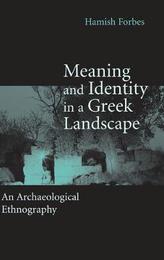
|
Meaning and Identity in a Greek Landscape: An Archaeological Ethnography
Hardback
Main Details
| Title |
Meaning and Identity in a Greek Landscape: An Archaeological Ethnography
|
| Authors and Contributors |
By (author) Hamish Forbes
|
| Physical Properties |
| Format:Hardback | | Pages:462 | | Dimensions(mm): Height 234,Width 159 |
|
| Category/Genre | Historical geography
Archaeology by period and region
Classical Greek and Roman archaeology |
|---|
| ISBN/Barcode |
9780521866996
|
| Classifications | Dewey:949.512 |
|---|
| Audience | | Professional & Vocational | |
|---|
|
Publishing Details |
| Publisher |
Cambridge University Press
|
| Imprint |
Cambridge University Press
|
| Publication Date |
1 October 2007 |
| Publication Country |
United Kingdom
|
Description
In this study, Hamish Forbes explores how Greek villagers have understood and reacted to their landscapes over the centuries, from the late medieval period to the present. Analyzing how they have seen themselves belonging to their local communities and within both local and wider landscapes, Forbes examines how these aspects of belonging have informed each other. Forbes also illuminates cross-disciplinary interests in memory and the importance of monuments. Based on data gathered over 25 years, Forbes' study combines the rich detail of ethnographic field work with historical and archaeological time-depth, showing how landscapes have important meaning beyond the religious sphere in terms of kinship, ideas about the past, and in their role as productive assets.
Author Biography
Hamish Forbes is associate professor of archaeology at the University of Nottingham. He has excavated in the USA, Ireland, Britain, and Greece and conducted ethnographic fieldwork in the Southern Argolid of Greece. He is the author of A Rough and Rocky Place: The Landscape and Settlement History of the Methana Peninsula, Greece.
ReviewsReview of the hardback: '... one can only be grateful to Forbes that decades of experiencing the cultures of Methana from the inside allow him to share with us here both the 'language' and 'literature' of its landscapes.' Cambridge Archaeological Journal
|